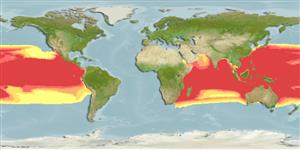Teleostei (teleosts) >
Beloniformes (Needle fishes) >
Exocoetidae (Flyingfishes)
Etymology: Cheilopogon: Greek, cheilos = lip + Greek, pogon = barbed, beard (Ref. 45335).
Issue
Genus B. Mundy, pers. comm. Date Eschmeyer, pers. comm.
Environment: milieu / climate zone / depth range / distribution range
Ecology
Marine; pelagic-oceanic; oceanodromous (Ref. 51243); depth range 0 - 10 m (Ref. 86942). Tropical
Indo-Pacific: Somalia and Madagascar to the Revillagigedo and Galapagos islands in the eastern Pacific. Absent from the inland seas of Indonesia and from Australian waters (Ref. 27313).
Size / Weight / Age
Maturity: Lm ? range ? - ? cm
Max length : 33.0 cm SL male/unsexed; (Ref. 9839)
Found in neritic and oceanic waters (Ref. 30573). Capable of leaping out of the water and gliding for considerable distances above the surface.
Life cycle and mating behavior
Maturity | Reproduction | Spawning | Eggs | Fecundity | Larvae
Parin, N.V., 1996. On the species composition of flying fishes (Exocoetidae) in the West-Central part of tropical Pacific. J. Ichthyol. 36(5):357-364. (Ref. 27313)
IUCN Red List Status (Ref. 130435: Version 2024-1)
Threat to humans
Harmless
Human uses
Fisheries: minor commercial
Tools
Special reports
Download XML
Internet sources
Estimates based on models
Preferred temperature (Ref.
123201): 23.4 - 29.2, mean 27.5 °C (based on 36001 cells).
Phylogenetic diversity index (Ref.
82804): PD
50 = 0.5000 [Uniqueness, from 0.5 = low to 2.0 = high].
Bayesian length-weight: a=0.00813 (0.00444 - 0.01488), b=3.06 (2.89 - 3.23), in cm total length, based on LWR estimates for this species & (Sub)family-body (Ref.
93245).
Trophic level (Ref.
69278): 3.7 ±0.5 se; based on size and trophs of closest relatives
Generation time: 1.2 ( na - na) years. Estimated as median ln(3)/K based on 1
growth studies.
Resilience (Ref.
120179): High, minimum population doubling time less than 15 months (K=0.8).
Fishing Vulnerability (Ref.
59153): Low vulnerability (21 of 100).
